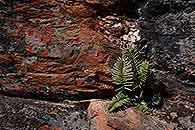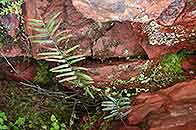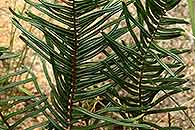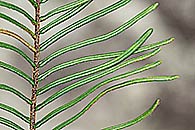Pellaea pectiniformis Baker
Synonyms |
Pellaea goudotii Kunze ex C. Chr. |
|---|---|
Common name |
|
Description |
Rhizome creeping to semi-erect, up to 8 mm in diameter; rhizome scales narrowly lanceolate, apex gradualy tapering to a point, subentire, 3-5 mm long, dark brown. Fronds monomorphic, tufted, erect, 25-50 cm tall, coriaceous. Stipe up to 30 cm long, dark brown to black, with short, brown, hairlike scales mixed with sparse larger and broader scales, becoming subglabrous with age. Lamina pinnate, narrowly oblong to lanceolate in outline, 13-30 × 3-9 cm; pinnae up to 48 pairs, linear in outline, apex rounded, base cordate, 1.2-6 × 0.1-0.6 cm, subopposite to alternate, articulated to a very short petiole, hairless above, sparsely hairy along the costae below; veins free, hardly visible; rhachis dark brown, thinly pilose. Sori marginal, continuous; indusium erose to entire, membranous, continuous. |
Notes | Unlike other Pellaea species P. pectiniformis is never bipinnate. It could be confused with P. doniana, which has broader and less numerous ovate-lanceolate pinnae. |
Derivation | pectiniformis: combshaped, referring to the shape of the lamina which has close, narrow and parallel pinnae. |
Habitat | Rock crevices, shallow soils on sheetrock, boulder bases and rocky outcrops in miombo woodland, exposed or lightly shaded. |
Distribution worldwide | Africa, Madagascar and Comoro Islands. |
Distribution in Africa |
Angola, Burundi, Dem. Republic of Congo, Gabon, Malawi, Mozambique, Namibia, Rwanda, South Africa, Swaziland, Tanzania , Zambia, Zimbabwe. |
Growth form |
Lithophytic, terrestrial. |
Literature |
|







